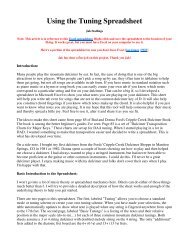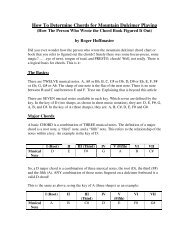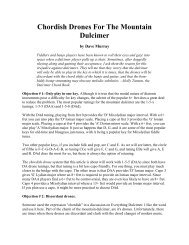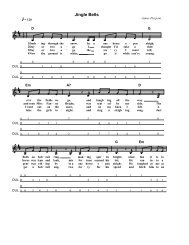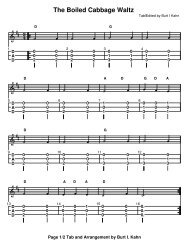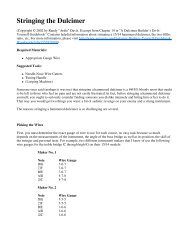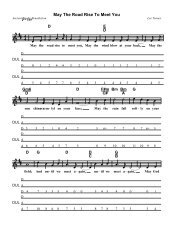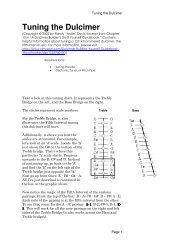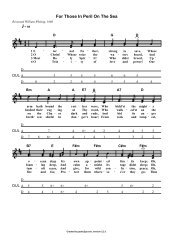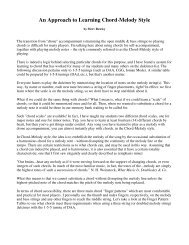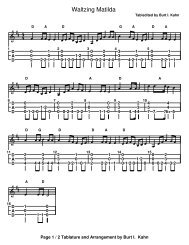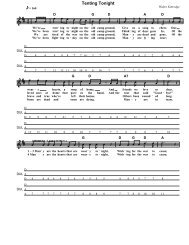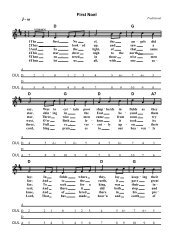amplifying your dulcimer - a basic course for the player in small ...
amplifying your dulcimer - a basic course for the player in small ...
amplifying your dulcimer - a basic course for the player in small ...
You also want an ePaper? Increase the reach of your titles
YUMPU automatically turns print PDFs into web optimized ePapers that Google loves.
AMPLIFYING YOUR DULCIMER ‐ A BASIC COURSE FOR THE PLAYER INSMALL VENUESBy Tim Smith (Tim2723)Ok, so you’ve been play<strong>in</strong>g <strong>your</strong> <strong>dulcimer</strong> <strong>for</strong> a while now and you’ve learned quite a few tunes.You sound good and <strong>your</strong> friends love it. Somebody asks you to play at <strong>the</strong>ir wedd<strong>in</strong>g, or at <strong>the</strong>church or retirement home. Be<strong>in</strong>g <strong>the</strong> swee<strong>the</strong>art that you are, you ga<strong>the</strong>r up <strong>your</strong> courageand go <strong>for</strong> it. Everybody loves you and you’re hooked. But <strong>the</strong>y couldn’t really hear you verywell.You and a friend or two play toge<strong>the</strong>r <strong>for</strong> fun and are th<strong>in</strong>k<strong>in</strong>g about play<strong>in</strong>g <strong>in</strong> <strong>the</strong> local coffeehouse. Even though it’s a pretty tame place, you know you’ll need a little someth<strong>in</strong>g more tobe heard <strong>in</strong> <strong>the</strong> back row. You’ve seen <strong>the</strong> o<strong>the</strong>r groups do it, but all those wires and boxes areunknown territory.Lots of <strong>dulcimer</strong> <strong>player</strong>s per<strong>for</strong>m on stage at festivals and ga<strong>the</strong>r<strong>in</strong>gs, and some even play <strong>in</strong>bands all <strong>the</strong> time. These folks have people to help <strong>the</strong>m with <strong>the</strong>ir sound or have becomeexperts <strong>the</strong>mselves through experience and may even have complex sound systems of <strong>the</strong>irown. But this article is <strong>for</strong> <strong>the</strong> solo musician or <strong>small</strong> group who needs a little more volume <strong>for</strong>those special occasions, and especially <strong>for</strong> those who don’t understand a th<strong>in</strong>g that <strong>the</strong> guy at<strong>the</strong> music store says.If any of this sounds like you, <strong>the</strong>n welcome! While we’ll talk mostly about <strong>the</strong> mounta<strong>in</strong><strong>dulcimer</strong> and hammered <strong>dulcimer</strong>, <strong>the</strong> <strong>basic</strong> <strong>in</strong><strong>for</strong>mation here can be adapted to practically anyacoustic <strong>in</strong>strument like guitars, mandol<strong>in</strong>s, and yes, even banjos and fiddles need helpsometimes. Take note that I won’t be mention<strong>in</strong>g any specific brand names, makes, or modelsof gear. In <strong>the</strong> music world equipment comes and goes so quickly that a specific item might beobsolete by <strong>the</strong> time you read this. Discussions about select<strong>in</strong>g brands and models are betterleft to <strong>the</strong> open <strong>for</strong>um where up to date <strong>in</strong><strong>for</strong>mation can be had.So <strong>for</strong> anyone who has waded endlessly through confus<strong>in</strong>g catalogs of musical gear or listenedto <strong>the</strong> salesperson at <strong>the</strong> music store with someth<strong>in</strong>g less than perfect confidence, a good firstquestion might be:WHAT DO I REALLY NEED?That’s a big question, but it can be broken down <strong>in</strong>to manageable chunks. The solo musician or
<strong>small</strong> group play<strong>in</strong>g to quiet, attentive crowds such as a wedd<strong>in</strong>g ceremony, church service, orcoffee house needs very little compared to <strong>the</strong> gigg<strong>in</strong>g band or tour<strong>in</strong>g group play<strong>in</strong>g to loudcrowds <strong>in</strong> big, noisy venues. And s<strong>in</strong>ce most <strong>dulcimer</strong> <strong>player</strong>s don’t need to rock out at earsplitt<strong>in</strong>gvolumes, th<strong>in</strong>gs can be simplified. You’ll need an <strong>in</strong>put device to capture <strong>the</strong> sound, anoutput device to make that sound louder, and a couple of o<strong>the</strong>r items to make everyth<strong>in</strong>g worktoge<strong>the</strong>r. It’s easier than you th<strong>in</strong>k.INPUT DEVICES, OR HOW TO GATHER UP THE SOUNDMICROPHONES are by far <strong>the</strong> most common <strong>in</strong>put device. They work by sens<strong>in</strong>g <strong>the</strong> vibrationsof <strong>the</strong> air around <strong>your</strong> <strong>in</strong>strument and turn<strong>in</strong>g that <strong>in</strong>to an electrical signal that an amplifier canuse. Microphones are, of <strong>course</strong>, <strong>the</strong> only choice <strong>for</strong> s<strong>in</strong>g<strong>in</strong>g, but <strong>the</strong>y are used <strong>for</strong> all k<strong>in</strong>ds of<strong>in</strong>struments. If someth<strong>in</strong>g makes a sound, a microphone will make it louder. There are two<strong>basic</strong> k<strong>in</strong>ds:The DYNAMIC MICROPHONE. These come <strong>in</strong> a vast assortment of brands and models. Goodones are rugged, reliable, easy to use, and readily available. They connect directly to <strong>your</strong>amplifier with a simple cord. The ‘cardioid’ version of <strong>the</strong> dynamic microphone picks up lesssound from beh<strong>in</strong>d and from <strong>the</strong> sides, so it is less prone to feedback, that horrible screech<strong>in</strong>gnoise that happens whenever a microphone and a speaker ‘hear’ each o<strong>the</strong>r.The CONDENSER MICROPHONE works <strong>the</strong> same way, but it has a built‐<strong>in</strong> pre‐amplifier thatallows it to hear fa<strong>in</strong>ter sounds from far<strong>the</strong>r away. Their advantage is that <strong>the</strong>y don’t have tobe as close to <strong>your</strong> <strong>in</strong>strument to work, but <strong>the</strong>y are more prone to feedback and <strong>the</strong>y require abattery. Many condenser mics can use ‘phantom power’, a feature of some amplifiers thattakes <strong>the</strong> place of a battery. Condenser mics can hear everyth<strong>in</strong>g around <strong>the</strong>m, so be carefulwhat you say!Both dynamic and condenser microphones come <strong>in</strong> different sizes and styles. The hand‐heldstyle is supported by a microphone stand so that it po<strong>in</strong>ts <strong>in</strong>to <strong>your</strong> <strong>in</strong>strument. The contactstyle attaches directly to <strong>your</strong> <strong>in</strong>strument, usually with a suction cup or t<strong>in</strong>y bit of removableadhesive. Contact style microphones are less prone to feedback, but often result <strong>in</strong> a lot ofnoise as <strong>the</strong>y can ‘hear’ you handle <strong>your</strong> <strong>in</strong>strument. The lavaliere style are those littlemicrophones you see all <strong>the</strong> time on TV that clip onto a speaker’s cloth<strong>in</strong>g and are oftenadapted to clip onto an <strong>in</strong>strument. Most lavaliere microphones are <strong>the</strong> condenser type.TRANSDUCER PICKUPS work by directly sens<strong>in</strong>g <strong>the</strong> vibrations <strong>in</strong> <strong>the</strong> <strong>in</strong>strument itself andconvert<strong>in</strong>g those vibrations <strong>in</strong>to electricity. There are three major categories.
The UNDER‐BRIDGE PICKUP is built directly <strong>in</strong>to <strong>the</strong> bridge of <strong>your</strong> <strong>in</strong>strument. They can bepurchased when hav<strong>in</strong>g a <strong>dulcimer</strong> built, or <strong>in</strong>stalled afterwards. They require somemodifications to <strong>your</strong> <strong>dulcimer</strong>, like drill<strong>in</strong>g a <strong>small</strong> hole. This makes <strong>the</strong>ir <strong>in</strong>stallation best leftto a qualified technician.The SURFACE MOUNTED PICKUP, sometimes called a soundboard pickup, attaches to <strong>the</strong> woodof <strong>the</strong> <strong>in</strong>strument very easily with a bit of removable adhesive and can be moved from<strong>in</strong>strument to <strong>in</strong>strument. They can also be permanently <strong>in</strong>stalled <strong>in</strong>side <strong>the</strong> <strong>in</strong>strument, andwhen <strong>the</strong>y are, that too is best left to <strong>the</strong> professional technician.The MAGNETIC PICKUP is normally built <strong>in</strong>to <strong>the</strong> <strong>in</strong>strument when it is made. These are just like<strong>the</strong> pickups found <strong>in</strong> electric guitars, and usually show up only on solid‐body electric <strong>dulcimer</strong>s.Some pickups require a separate PRE‐AMPLIFIER that boosts <strong>the</strong> strength of <strong>the</strong> signal andhelps to adjust <strong>the</strong> sound be<strong>for</strong>e it enters <strong>the</strong> ma<strong>in</strong> amplifier. They have volume and tonecontrols and a battery to run <strong>the</strong>ir <strong>small</strong> on‐board amplifier. They go between <strong>the</strong> transducerand <strong>the</strong> ma<strong>in</strong> amplifier.The DIRECT BOX is an item that has generated a lot of confusion <strong>for</strong> <strong>the</strong> first‐time user. In itssimplest <strong>for</strong>m a direct box is a device used to send <strong>the</strong> <strong>in</strong>strument’s signal through long lengthsof cable without suffer<strong>in</strong>g loss. In recent years many manufacturers have <strong>in</strong>cluded lots ofadditional features <strong>in</strong> direct boxes, and some models have all <strong>the</strong> functions of <strong>the</strong> pre‐amplifieras well. The good part of this is that we can buy a s<strong>in</strong>gle item that has many features, <strong>the</strong> badpart is that it can be very confus<strong>in</strong>g. For <strong>the</strong> <strong>small</strong> systems described here, <strong>the</strong> direct box is nota necessary tool, although <strong>the</strong> pre‐amplifier feature might be useful.SO WHICH ONE IS RIGHT FOR ME?That’s probably <strong>the</strong> hardest s<strong>in</strong>gle question of all, and <strong>in</strong> <strong>the</strong> end every <strong>player</strong> must decidewhat’s best <strong>for</strong> <strong>the</strong>mselves. To summarize <strong>the</strong> pros and cons:Microphones give <strong>the</strong> best chance of a perfect acoustic reproduction, and many <strong>player</strong>s willsettle <strong>for</strong> noth<strong>in</strong>g less. They require no modification of <strong>your</strong> <strong>dulcimer</strong>, and any acoustic<strong>in</strong>strument can play <strong>in</strong>to one. They take <strong>the</strong> most ef<strong>for</strong>t, skill, and practice to use. They usually<strong>in</strong>volve carry<strong>in</strong>g more gear and tak<strong>in</strong>g up more space, and can be very prone to feedback. Theirper<strong>for</strong>mance varies if you move <strong>your</strong> <strong>in</strong>strument when you play, and <strong>the</strong>y are not suitable <strong>for</strong>MD <strong>player</strong>s who stand up and move around <strong>the</strong> stage. Cardioid and hyper‐cardioid designs help
control feedback from reflected sound.Transducers are dead simple to operate, are nearly trouble‐free, and require buy<strong>in</strong>g, carry<strong>in</strong>g,and handl<strong>in</strong>g far less equipment. They are especially suitable <strong>for</strong> use <strong>in</strong> tight, cramped quarters.They are prone to handl<strong>in</strong>g noise and often have a less than perfect acoustic reproduction. Ifattached to <strong>the</strong> outside of <strong>the</strong> <strong>in</strong>strument <strong>the</strong>y are easily removed, but some folks th<strong>in</strong>k that isugly. Putt<strong>in</strong>g <strong>the</strong>m <strong>in</strong>side can mean modify<strong>in</strong>g <strong>your</strong> <strong>dulcimer</strong> permanently, and not alltransducer types are available <strong>for</strong> all <strong>in</strong>struments. A transducer may need an additional preamplifier.OUTPUT DEVICES, OR GETTING THE SOUND TO THE CROWDSimply put, <strong>the</strong>se are <strong>the</strong> amplifiers. There is a bewilder<strong>in</strong>g variety of <strong>the</strong>se, but <strong>the</strong>y fall <strong>in</strong>tosome manageable categories.The ELECTRIC GUITAR AMP. For someone play<strong>in</strong>g a solid‐body electric <strong>dulcimer</strong>, this is often<strong>the</strong> first choice. For <strong>the</strong> acoustic soloist need<strong>in</strong>g only to amplify <strong>the</strong> <strong>dulcimer</strong> alone <strong>the</strong>se canbe handy, if not optimum, choices. It’s often asked “My son has a guitar amplifier. Can I usethis <strong>for</strong> my <strong>dulcimer</strong>?” Yes, you can. While not ideal <strong>for</strong> microphones, you can plug atransducer <strong>in</strong>to <strong>the</strong> ‘clean’ channel of <strong>the</strong> guitar amp. The biggest problem with electric guitaramps is that <strong>the</strong>y are designed to modify <strong>the</strong> sound of <strong>the</strong> <strong>in</strong>strument as well as make it louder.That’s important to electric guitar <strong>player</strong>s and electric <strong>dulcimer</strong> <strong>player</strong>s alike, but not soimportant <strong>for</strong> <strong>the</strong> acoustic dulcimist want<strong>in</strong>g a natural sound. While not ideal, <strong>the</strong>y can workwell <strong>for</strong> <strong>small</strong> crowds. For those who are especially concerned about reproduc<strong>in</strong>g <strong>the</strong> acousticsound, or who expect to play on a more frequent basis, <strong>in</strong>vest<strong>in</strong>g <strong>in</strong> ano<strong>the</strong>r k<strong>in</strong>d of amp isusually desirable.The ACOUSTIC AMPLIFIER is, <strong>for</strong> all <strong>in</strong>tents and purposes, a <strong>small</strong> self‐conta<strong>in</strong>ed public addresssystem. They are designed to give a very realistic sound. Many also allow you to usemicrophones, transducers, or even both at once. For <strong>in</strong>stance, depend<strong>in</strong>g on <strong>the</strong> particularmodel you could amplify both <strong>your</strong> <strong>dulcimer</strong> and ano<strong>the</strong>r <strong>in</strong>strument or a vocal microphone <strong>for</strong>s<strong>in</strong>g<strong>in</strong>g. For those who want very realistic sound, want to s<strong>in</strong>g and play at <strong>the</strong> same time, orhave a friend who plays along on ano<strong>the</strong>r <strong>in</strong>strument, <strong>the</strong> acoustic amp is often a top choice.There are even battery‐powered models that are very handy <strong>for</strong> play<strong>in</strong>g outdoors.The PUBLIC ADDRESS SYSTEM or PA is <strong>the</strong> recommended solution <strong>for</strong> anyone who plays <strong>in</strong>many different locations where <strong>the</strong>y need maximum flexibility, and <strong>for</strong> <strong>small</strong> groups who needto amplify a number of <strong>in</strong>struments or voices. The primary differences between acoustic
amplifiers and PA systems are that PAs can be much more powerful, <strong>the</strong>y have separatespeakers that can be placed where <strong>the</strong>y will work best, are versatile <strong>for</strong> solv<strong>in</strong>g countlessproblems, and have multiple <strong>in</strong>puts <strong>for</strong> lots of <strong>in</strong>struments and s<strong>in</strong>gers. The simplest PAsystems consist of a pair of speaker cab<strong>in</strong>ets and a box that conta<strong>in</strong>s <strong>the</strong> ‘guts’ of <strong>the</strong> amplifierand all <strong>the</strong> controls. Surpris<strong>in</strong>gly, while <strong>the</strong>y have more pieces, <strong>in</strong> <strong>small</strong> PA systems those piecescan be very light and compact and are often much easier to carry. For <strong>the</strong> someone who isplay<strong>in</strong>g <strong>in</strong> lots of new places with unexpected conditions <strong>the</strong> PA is <strong>the</strong> number one choice. Forduos and <strong>small</strong> groups, especially <strong>for</strong> those who s<strong>in</strong>g and play, <strong>the</strong> PA is <strong>the</strong> se!rious tool.HOW POWERFULL SHOULD MY AMPLIFIER BE?S<strong>in</strong>ce we’re talk<strong>in</strong>g about play<strong>in</strong>g <strong>in</strong> <strong>small</strong>er venues to quiet, attentive audiences, <strong>the</strong> answer is“Not as much as you might th<strong>in</strong>k”. While big, ear‐splitt<strong>in</strong>g amplifiers are desired and evenneeded by a lot of musicians, you’ll f<strong>in</strong>d that most <strong>dulcimer</strong> audiences expect to hear youwithout suffer<strong>in</strong>g from you. And of <strong>course</strong>, most churches honestly don’t want you rattl<strong>in</strong>g<strong>the</strong>ir sta<strong>in</strong>ed glass. For most people <strong>dulcimer</strong>s are, by <strong>the</strong>ir nature, an <strong>in</strong>strument you sitquietly and listen to. For <strong>the</strong> vast majority of <strong>player</strong>s <strong>in</strong> <strong>the</strong> k<strong>in</strong>ds of venues we’re discuss<strong>in</strong>g, a50 to 75 watt amp will handle most needs. If us<strong>in</strong>g a PA system <strong>for</strong> multiple per<strong>for</strong>mers, 100 to200 watts is almost always sufficient <strong>for</strong> <strong>the</strong> k<strong>in</strong>ds of places we’re talk<strong>in</strong>g about. Even if you’replay<strong>in</strong>g <strong>the</strong> cocktail hour <strong>for</strong> a wedd<strong>in</strong>g reception, <strong>the</strong> crowd will be quieter than it will becomeonce <strong>the</strong> DJ starts <strong>the</strong> dance music. If you expect to play outdoors, <strong>the</strong>n go <strong>for</strong> <strong>the</strong> larger sizesof <strong>the</strong> ranges shown or even beyond. !Outdoor play<strong>in</strong>g <strong>in</strong>variably requires more power.You will often hear advice about ‘never hav<strong>in</strong>g enough amp’. For a great many (<strong>in</strong>deed most)musicians, this is usually true. But amplifiers are funny th<strong>in</strong>gs. Small amps don’t like to beturned way up to <strong>the</strong> top of <strong>the</strong>ir limit and big amps hate to play turned way down low. For <strong>the</strong>majority of <strong>small</strong> venues, <strong>small</strong>er amps are actually better. The only th<strong>in</strong>g I would personallyadvise <strong>dulcimer</strong> <strong>player</strong>s to avoid are really huge systems. In <strong>the</strong> circumstances where you’llneed it, like festivals and fairs, <strong>the</strong> really big gear is usually provided and operated by pros. Ifyou’re <strong>in</strong> a band that plays large, noisy rooms with raucous crowds, well, that’s ano<strong>the</strong>r storytoo.SETTING IT ALL UPOnce you’ve chosen <strong>your</strong> <strong>in</strong>put device and <strong>the</strong> amp type you’ll need, <strong>the</strong>n what else? Well,you’ll need some cable. The k<strong>in</strong>d of cable you’ll need depends on <strong>the</strong> mic or transducer you
have and <strong>the</strong> k<strong>in</strong>d of connectors <strong>the</strong>y use, but <strong>the</strong> right cables can be bought at any musicstore. The best advise I can th<strong>in</strong>k of is to have <strong>your</strong> cable a little longer than you th<strong>in</strong>k you’llneed, and don’t buy cheap ones. Cheap cables are disasters wait<strong>in</strong>g to happen. Nor is <strong>the</strong>reany need to <strong>in</strong>vest <strong>in</strong> excessively long cables. When play<strong>in</strong>g <strong>the</strong> <strong>small</strong> venue, you will be quitenear <strong>the</strong> amplifier, and excessively long cables are not only clumsy and expensive, but can evendegrade <strong>your</strong> sound. A 15 to 20 foot cable meets <strong>the</strong> need almost every time with length tospare.If you’ve chosen a <strong>small</strong> PA system, it will likely come with speaker wires to connect <strong>the</strong>amplifier to <strong>the</strong> speakers. It’s important to use speaker wires only <strong>for</strong> speakers, and<strong>in</strong>strument/mic cables only <strong>for</strong> <strong>the</strong>ir particular purposes. They are not <strong>in</strong>terchangeable, eventhough <strong>the</strong>y might have <strong>the</strong> same k<strong>in</strong>d of connectors. Your PA will come with directions <strong>for</strong>proper hook up. Follow <strong>the</strong>m closely. Plugg<strong>in</strong>g <strong>the</strong> wrong cord <strong>in</strong>to <strong>the</strong> wrong place can result<strong>in</strong> damage. To protect <strong>your</strong> amplifier, make sure <strong>the</strong> speakers are correctly plugged <strong>in</strong> be<strong>for</strong>eyou turn <strong>the</strong> power on. An amplifier without speakers attached can be damaged by heat.It’s always a good idea to have a high quality extension cord to reach <strong>the</strong> power outlet. If youplay outdoors, make sure to get an outdoor type. Much to <strong>your</strong> chagr<strong>in</strong>, you may need to plug<strong>your</strong> amplifier <strong>in</strong>to an outlet that isn’t <strong>the</strong> one that’s right next to you. Sometimes, <strong>in</strong> fact,often, you have to go <strong>in</strong> search of a ‘clean’ outlet. O<strong>the</strong>r devices that are on <strong>the</strong> same circuit as<strong>your</strong> amplifier can often cause audible hums and buzz<strong>in</strong>g.For hand‐held style mics, you’ll need a microphone stand and boom. These let you position <strong>the</strong>mic <strong>for</strong> <strong>the</strong> best sound. With <strong>dulcimer</strong>s <strong>the</strong> mic often ends up po<strong>in</strong>t<strong>in</strong>g nearly straight down.To avoid los<strong>in</strong>g it <strong>in</strong> <strong>the</strong> middle of a tune and hav<strong>in</strong>g it crash <strong>in</strong>to <strong>your</strong> <strong>in</strong>strument, secure it <strong>in</strong>its holder with a bit of electrical tape or better yet, gaffer’s tape available <strong>in</strong> most larger musicshops or on‐l<strong>in</strong>e.When select<strong>in</strong>g mic stands, stability is <strong>the</strong> watchword. A wobbly stand is no good at all. Standscome <strong>in</strong> a variety of styles and sizes. One of <strong>the</strong> handiest has three telescop<strong>in</strong>g sections. Thisallows it to be very low or very high when you need it, and <strong>the</strong>se are especially good <strong>for</strong>hammered <strong>dulcimer</strong>s <strong>player</strong>s who use a microphone under <strong>the</strong>ir <strong>in</strong>strument. Some havefold<strong>in</strong>g legs, o<strong>the</strong>rs have heavy, cast iron bases. Fold<strong>in</strong>g is nice, but heavy is stable.GETTING THE MOST OUT OF ITUs<strong>in</strong>g sound re<strong>in</strong><strong>for</strong>cement <strong>for</strong> <strong>the</strong> <strong>small</strong> venue is not difficult but it can be challeng<strong>in</strong>g. While<strong>the</strong>re is no substitute <strong>for</strong> experience, <strong>the</strong>re are a number of simple rules of thumb that will get
you through those first few nervous per<strong>for</strong>mances.If you’ve never played through an amplifier you’re <strong>in</strong> <strong>for</strong> a surprise. It’s like <strong>the</strong> first time youever heard <strong>your</strong> own recorded voice. You‘re likely to say “Is that ME!?” The first two commonreactions to this are both mistakes. First, do not suddenly play shyly. The whole idea is to belouder. Play as you normally do and let <strong>the</strong> amplifier do <strong>the</strong> work. Second, do not automaticallyre‐adjust <strong>the</strong> controls of <strong>your</strong> amplifier to change what you THINK you hear. What does thatmean?Have you ever heard someone play<strong>in</strong>g through an amplifier and not liked <strong>the</strong> quality of <strong>the</strong>sound? Odds are that if you sat next to <strong>the</strong> <strong>player</strong>, th<strong>in</strong>gs would sound much better. When youare very near or beh<strong>in</strong>d a loudspeaker th<strong>in</strong>gs will sound different to you than <strong>the</strong>y do to <strong>the</strong>audience. A common problem happens when <strong>the</strong> musician adjusts <strong>the</strong> amplifier to sound goodon stage while <strong>the</strong> sound <strong>the</strong> audience hears is completely different (and often terrible!). Ittakes time and practice to get used to hear<strong>in</strong>g <strong>your</strong>self through an amplifier. It sounds weirdand alien at first, but you will adjust to it <strong>in</strong> time. In large, complex sound systems <strong>the</strong>re areways of correct<strong>in</strong>g <strong>for</strong> this, but here we are discuss<strong>in</strong>g <strong>the</strong> <strong>small</strong>, simple set up.When adjust<strong>in</strong>g <strong>the</strong> controls of <strong>your</strong> amplifier it’s a good idea to have a friend help out, ei<strong>the</strong>rby stand<strong>in</strong>g out <strong>in</strong> front to give advice about how th<strong>in</strong>gs sound, or by speak<strong>in</strong>g <strong>in</strong>to <strong>your</strong>microphone or strumm<strong>in</strong>g <strong>your</strong> <strong>in</strong>strument while you listen. If us<strong>in</strong>g a microphone, have <strong>your</strong>friend speak <strong>in</strong>to it normally. Start with <strong>the</strong> volume at zero and <strong>the</strong> EQUALIZATION controls(treble, mid‐range if <strong>the</strong>re is one, and bass) set at <strong>the</strong> 12 o’clock positions, and <strong>the</strong> sliders of<strong>your</strong> graphic equalizer set to <strong>the</strong>ir middle positions.. Turn on <strong>the</strong> power and <strong>in</strong>crease <strong>the</strong>volume slowly to avoid feedback. Adjust <strong>the</strong> bass if you sound muddy and <strong>the</strong> treble if yousound t<strong>in</strong>ny. The objective is to get a natural sound. With a microphone, if <strong>your</strong> friend’s voicesounds normal, <strong>your</strong> <strong>in</strong>strument will too. For transducers, it is a matter of adjust<strong>in</strong>g <strong>the</strong>controls to get an even response from <strong>the</strong> treble and bass str<strong>in</strong>gs. Take <strong>your</strong> time andremember that turn<strong>in</strong>g <strong>the</strong>se knobs will hurt noth<strong>in</strong>g.Probably <strong>the</strong> biggest s<strong>in</strong>gle trap that <strong>player</strong>s fall <strong>in</strong>to is <strong>in</strong> try<strong>in</strong>g to use <strong>the</strong> sound system tochange <strong>the</strong> tone of <strong>the</strong>ir <strong>in</strong>struments or voices. For acoustic <strong>player</strong>s, you won’t add lower notesby turn<strong>in</strong>g up <strong>the</strong> bass, you’ll just get muddy sound and probably feedback. Conversely, if youwant <strong>your</strong> <strong>in</strong>strument to sound brighter, you need to get a brighter <strong>dulcimer</strong>. Turn<strong>in</strong>g up <strong>the</strong>treble is not <strong>the</strong> solution. Unlike <strong>the</strong> electric guitar (or <strong>dulcimer</strong>) that is deigned to have abroad range of tones, an acoustic <strong>in</strong>strument can really only sound more or less like itself, butlouder. This is especially true when us<strong>in</strong>g microphones.
Once you have a natural sound that you like you need to get loud enough, and <strong>the</strong> next biggestproblem you’ll likely encounter is feedback. When play<strong>in</strong>g at low volumes feedback almostnever happens, and <strong>in</strong> most <strong>small</strong>, quiet rooms where you’re not push<strong>in</strong>g <strong>the</strong> amplifier you cansometimes get away with break<strong>in</strong>g a lot of rules and not have feedback. But if you do have it<strong>the</strong>re are a couple of rules of thumb.The first most important consideration <strong>for</strong> feedback control is to no let <strong>the</strong> microphone ‘hear’<strong>the</strong> speaker. This means plac<strong>in</strong>g <strong>your</strong> amp or PA speakers <strong>in</strong> positions where <strong>the</strong>y don’t po<strong>in</strong>t<strong>in</strong>to <strong>the</strong> microphones. Keep speakers <strong>in</strong> front of you if you’re play<strong>in</strong>g loud. Po<strong>in</strong>t <strong>the</strong>m slightlyaway from <strong>the</strong> mics.Your amplifier will likely have at least two volume controls. One will be marked MASTER anddoes just what it sounds like it does. It controls <strong>the</strong> overall volume of <strong>the</strong> amplifier. The o<strong>the</strong>ris <strong>the</strong> GAIN control. That is <strong>the</strong> <strong>in</strong>put volume com<strong>in</strong>g <strong>in</strong>to <strong>the</strong> ma<strong>in</strong> part of amplifier from <strong>your</strong><strong>in</strong>strument. That control should normally be set lower than <strong>the</strong> master control. The higher youset <strong>the</strong> ga<strong>in</strong> <strong>the</strong> more sensitive <strong>your</strong> microphone or transducer becomes and <strong>the</strong> more likelyyou will be to have excessive noise and feedback. A <strong>basic</strong> rule of thumb is to put a <strong>small</strong>volume <strong>in</strong>to a larger one.Many amplifiers have a GRAPHIC EQUALIZER, a series of <strong>small</strong> slid<strong>in</strong>g switches that control <strong>the</strong>overall response of <strong>the</strong> amplifier. While it is used to control <strong>the</strong> general output of <strong>the</strong> amplifier,it is also a primary tool <strong>for</strong> correct<strong>in</strong>g feedback. It helps to th<strong>in</strong>k of a graphic equalizer (or EQ) isa comb<strong>in</strong>ation tone and volume control that is broken up <strong>in</strong>to <strong>small</strong> sections from bass totreble. It allows you to reduce <strong>the</strong> volume of only that part of <strong>the</strong> sound that is caus<strong>in</strong>gfeedback. Gett<strong>in</strong>g good at us<strong>in</strong>g <strong>the</strong> EQ is a big step <strong>in</strong> gett<strong>in</strong>g <strong>the</strong> most from <strong>your</strong> set up, sopractice with it. By reduc<strong>in</strong>g <strong>the</strong> volume of each slid<strong>in</strong>g switch <strong>in</strong> turn, you can usually isolate<strong>the</strong> particular part of <strong>the</strong> sound (or frequency) that is caus<strong>in</strong>g <strong>the</strong> feedback.Mostly, if feedback happens, turn <strong>the</strong> amp off, turn <strong>the</strong> volume down, and start aga<strong>in</strong>.Reposition <strong>the</strong> speaker(s), turn down <strong>the</strong> ga<strong>in</strong>, and adjust <strong>the</strong> equalization. Often reduc<strong>in</strong>g <strong>the</strong>bass or treble slightly with help with feedback.F<strong>in</strong>ally, <strong>your</strong> objective is to get enough volume <strong>for</strong> <strong>the</strong> job. This really means hav<strong>in</strong>g MOREvolume than you th<strong>in</strong>k you will need without any feedback, <strong>the</strong>n turn<strong>in</strong>g <strong>the</strong> system down towhere you actually want it. Sound technicians call this ‘r<strong>in</strong>g<strong>in</strong>g out’. If <strong>the</strong> set up will run at ahigher‐than‐needed volume without feedback, you are far less likely to encounter it dur<strong>in</strong>g <strong>your</strong>per<strong>for</strong>mance. If you get feedback as you <strong>in</strong>crease <strong>the</strong> volume, stop and re‐adjust. There is noperfect answer, but you will ga<strong>in</strong> experience with just a little practice and patience.
Why have I mentioned so much about feedback? Simple. Dulcimer <strong>player</strong>s put <strong>the</strong>irmicrophones <strong>in</strong> that odd position of po<strong>in</strong>t<strong>in</strong>g straight up or down. Microphones really hatethat. They are designed to be held more or less horizontally to avoid feedback, and when we<strong>dulcimer</strong> <strong>player</strong>s use <strong>the</strong>m <strong>the</strong> way we do, we’re ask<strong>in</strong>g <strong>for</strong> trouble.Ano<strong>the</strong>r important tip <strong>in</strong> gett<strong>in</strong>g <strong>the</strong> most from <strong>your</strong> amp is that <strong>the</strong>y work better if <strong>the</strong>y are uphigh. Plac<strong>in</strong>g <strong>your</strong> guitar or acoustic amp on a chair or tall stool will get you a lot moreper<strong>for</strong>mance, and most modern PA systems use tall tripod stands to place <strong>the</strong> speakers up high.Gett<strong>in</strong>g <strong>the</strong> speaker(s) off <strong>the</strong> ground can make <strong>your</strong> <strong>small</strong> amp per<strong>for</strong>m like a much larger one.MICROPHONE PLACEMENT ‐ THE KEY TO OPTIMUM TONEIf you’re us<strong>in</strong>g a transducer pickup and have achieved <strong>your</strong> desired tone at enough volumewithout feedback, congratulations. You can skip this step. If you’re us<strong>in</strong>g microphones,especially <strong>the</strong> stand‐mounted k<strong>in</strong>d, read on.It is common knowledge among experienced <strong>player</strong>s that plac<strong>in</strong>g <strong>the</strong> mic <strong>in</strong> just <strong>the</strong> right spotmeans everyth<strong>in</strong>g <strong>for</strong> good response and per<strong>for</strong>mance. Even mov<strong>in</strong>g <strong>the</strong> mic an <strong>in</strong>ch canchange <strong>the</strong> sound enough to notice. This is called <strong>the</strong> ‘proximity effect’. It is especiallynoticeable to vocalists who can change <strong>the</strong> very nature of <strong>the</strong>ir sound by mov<strong>in</strong>g close to <strong>the</strong>mic and s<strong>in</strong>g<strong>in</strong>g softly or mov<strong>in</strong>g away and s<strong>in</strong>g<strong>in</strong>g louder. Be sure to spend some timeexperiment<strong>in</strong>g with <strong>your</strong> microphone placement and gett<strong>in</strong>g lots of <strong>in</strong>put from <strong>your</strong> friendsstand<strong>in</strong>g out front. It’s important to th<strong>in</strong>k of <strong>your</strong> microphone as a musical <strong>in</strong>strument <strong>in</strong> itsown right.Dynamic microphones often need to be placed right up close to <strong>the</strong> <strong>in</strong>strument to get <strong>the</strong>strongest signal. This can impart a warm tone to <strong>the</strong> <strong>in</strong>strument, but can sometimes get <strong>in</strong> <strong>the</strong>way when play<strong>in</strong>g. Condenser microphones with <strong>the</strong>ir built‐<strong>in</strong> pre‐amplifiers can be placed a agreater distance away. They can give a very natural representation of <strong>your</strong> sound, butremember that <strong>the</strong>y hear everyth<strong>in</strong>g around <strong>the</strong>m, <strong>in</strong>clud<strong>in</strong>g all <strong>the</strong> little shuffles and whispers.For any microphone, <strong>the</strong> ideal location is where it will receive <strong>the</strong> most sound to amplify. Thatmeans <strong>in</strong> front of a sound hole. But you may f<strong>in</strong>d that this doesn’t necessarily give <strong>the</strong> mostnatural tone. Why is that? It’s because <strong>the</strong> sound we hear when we play is a comb<strong>in</strong>ation ofsources. We not only hear <strong>the</strong> sound from <strong>the</strong> holes, but we hear reflections as well. We’renot just listen<strong>in</strong>g to a s<strong>in</strong>gle sound hole, but <strong>the</strong> output of all of <strong>the</strong>m at once, and <strong>the</strong> overallvibration of <strong>the</strong> <strong>in</strong>strument itself. Because of this, you may f<strong>in</strong>d that <strong>your</strong> ideal location <strong>for</strong>
tone is not exactly where you th<strong>in</strong>k it ought to be. Don’t be surprised if you like <strong>the</strong> sound of<strong>your</strong> mic somewhere <strong>in</strong> <strong>the</strong> middle of <strong>your</strong> <strong>in</strong>strument. And too, many <strong>player</strong>s like <strong>the</strong> sound oftwo or more microphones. This is especially true <strong>for</strong> hammered dulcimist.The <strong>dulcimer</strong>s have a couple of unique challenges ow<strong>in</strong>g to <strong>the</strong>ir designs. Simply put, <strong>the</strong> soundholes are po<strong>in</strong>t<strong>in</strong>g <strong>in</strong> <strong>the</strong> wrong directions. In mounta<strong>in</strong> <strong>dulcimer</strong>s <strong>the</strong> holes most often po<strong>in</strong>t to<strong>the</strong> ceil<strong>in</strong>g. In hammered <strong>dulcimer</strong>s <strong>the</strong>y po<strong>in</strong>t at an angle back to <strong>the</strong> <strong>player</strong>, away from <strong>the</strong>audience. Even those designs with additional sound holes <strong>in</strong> <strong>the</strong>ir backs end up play<strong>in</strong>g at anangle <strong>in</strong>to <strong>the</strong> floor. In <strong>the</strong>se situations some HD <strong>player</strong>s use a mic under <strong>the</strong>ir <strong>in</strong>strument.These challenges can be more successfully met by us<strong>in</strong>g ‘cardioid’ or even ‘hyper‐cardioid’microphones. These are models that reject sound com<strong>in</strong>g from <strong>the</strong> sides and back, and hearmostly <strong>the</strong> sound com<strong>in</strong>g directly <strong>in</strong> from <strong>the</strong> front. They are much better at avoid<strong>in</strong>g feedbackcaused by <strong>the</strong> unusual placements of microphones used with <strong>dulcimer</strong>s.One of <strong>the</strong> most important words of advice I th<strong>in</strong>k I’ve ever received is to practice with <strong>the</strong>sound system at home on a regular basis until you really understand it and are com<strong>for</strong>tableus<strong>in</strong>g it. Do not expect to buy a <strong>small</strong> system and be an expert immediately. Giv<strong>in</strong>g a goodamplified per<strong>for</strong>mance means <strong>in</strong>corporat<strong>in</strong>g <strong>the</strong> sound gear <strong>in</strong>to <strong>your</strong> play<strong>in</strong>g. You can alwaystell <strong>the</strong> <strong>player</strong>s who are not com<strong>for</strong>table with sound equipment, but just a little practicesmoo<strong>the</strong>s out those rough edges and you’ll f<strong>in</strong>d that <strong>the</strong> equipment just seems to disappear.A FEW FINAL WORDSWell, not really. The subject of sound re<strong>in</strong><strong>for</strong>cement fills whole books. Short articles oftenraise as many questions as <strong>the</strong>y answer, but that’s OK. Hav<strong>in</strong>g <strong>the</strong> right questions to ask is justas important. While noth<strong>in</strong>g can replace personal experience, I hope you’ve come away fromthis little article with a better understand<strong>in</strong>g of <strong>the</strong> <strong>small</strong> sound system and its use. I hope that<strong>the</strong> next time you pick up a catalog or go <strong>in</strong>to that music store you’ll have a little moreconfidence and be armed with a <strong>basic</strong> knowledge of <strong>the</strong> k<strong>in</strong>ds of equipment you’ll encounterand a better idea of what you’ll need to get out <strong>the</strong>re and play loud!



